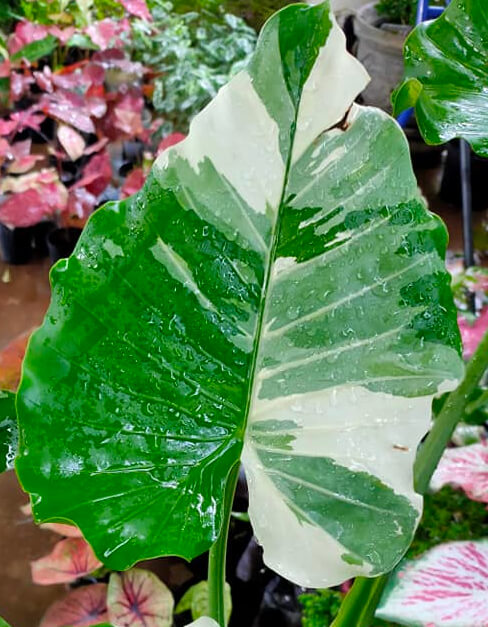Basic Information
Let’s explore how to take care of the Alocasia ‘Okinawa Silver’. I’ll provide you with some valuable tips that will help you nurture this stunning tropical plant.



Light
Alocasia ‘Okinawa Silver’ thrives in environments that mimic its native habitat, shaded from harsh sunlight. It prefers filtered or indirect light, making it perfect for bright indoor spaces. Direct sunlight is a no-go, as it can cause the leaves to burn. A partially shaded spot that avoids the intense afternoon sun is ideal to maintain its vibrant foliage.
Water
Proper hydration is crucial for the Alocasia ‘Okinawa Silver’ plant as it demands adequate water during its growing season due to its large leaves. It’s important to keep the soil consistently moist but not waterlogged. In winter, when the plant goes dormant, reduce watering to prevent root rot, and make sure to let the soil surface dry out before the next watering.
Soil
Use a well-draining potting mix of peat, perlite, and organic matter that holds moisture but drains excess water. Avoid heavy, clay-based soils. The plant prefers loose, well-drained soil that retains moisture without waterlogging.
Temperature
Alocasia ‘Okinawa Silver’ prefers a warm climate, ideally between 20-30°C. It can tolerate a minimum temperature of 8°C but is sensitive to cold drafts and sudden temperature drops. Keep it away from cold windows and air conditioning vents in cooler months.
Humidity
Humidity is another critical factor for this plant’s well-being. Originating from tropical regions, it loves a humid environment. Maintaining a relative humidity level above 60% is ideal. If your home is dry, consider using a humidifier or misting the leaves to keep them happy.
Fertilizer
Feed your Alocasia every two weeks during the growing season with a diluted liquid fertilizer. Reduce feeding in winter as the plant’s growth slows down. Over-fertilization can cause leaf burn, so it’s important to follow recommended dilution rates.
Growth Rate
This Alocasia is known for its rapid growth under optimal conditions. It can develop large, showy leaves fairly quickly. If you notice a slowdown in growth, it might indicate a need for more fertilizer or water adjustments.
Pet Safety
Caution is advised for pet owners, as this plant is toxic to cats and dogs. The leaves, stems, and roots contain calcium oxalates, which can cause severe reactions if ingested. Symptoms may include swelling, difficulty eating, and even kidney failure in extreme cases. It’s best to keep this plant out of reach of curious pets.
Grow in Semi-Hydro
- Alocasia plants excel in Semi-hydroponics (LECA/Pon) due to their natural inclination for root growth and humidity.
- Successfully transitioning Alocasia to Semi-hydroponics is enhanced with a Nutrient Stagnant Wicking (NSW) setup.
- Alocasia roots adapt seamlessly to the water in LECA/Pon, with quick resolution of any root hair issues in NSW setups.
- Fertilizer includes a nutrient mix concentration of approximately 800-1000ppm.
- These plants are versatile in different temperature and humidity settings, thriving in controlled environments.
- Long-term care involves maintaining a constant water reservoir and performing occasional system flushes for sustained growth.
Tips
- Avoid direct sunlight to prevent leaf burn.
- Keep the soil consistently moist but not waterlogged.
- Use a well-draining soil mix.
- Maintain a warm and humid environment.
- Fertilize regularly during the growing season.
- Monitor for pests and diseases and act promptly.
- Consider using a pebble tray to increase humidity.
- Prune dead or yellowing leaves to encourage new growth.
Grow a healthy Alocasia ‘Okinawa Silver’ with these tips, and add an exotic touch to your space. Enjoy the tropical vibe it brings!
Happy planting! 🌱


